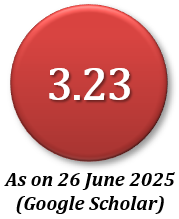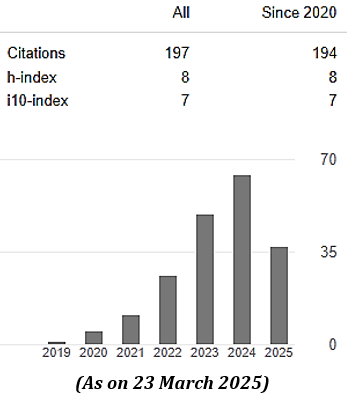An Optimized Energy Harvesting Circuit for Low-Power IoT Applications
Abstract
The concept and development of an independent energy harvesting mechanism functioning intermittently are described in this paper. A power management circuit (PMC) that is self-regulating, an energy scavenging module, a circuit for charging batteries, as well as an electronic load are all a component of the system that has been proposed. This proposed circuit is designed to attain a fixed output power with a diverse input range. In the unavailability of an additional voltage supply, the PMC can react, maintain, and smartly control the electronic load's power supply. The self-powered energy accumulating technique is expected to be used in situations when supplied power is inadequate to drive the load properly, such as Internet of Things (IoT) applications. IoT is a dispersed architecture of reduced-power, limited-storage, lightweight, and nodes that are adaptive. The majority of embedded IoT devices and low-power IoT sensors are driven by short-life batteries that must be replaced every few years. This procedure is expensive and efficient energy regulation could be critical in enabling energy savings for connecting IoT devices. Experiments with the proposed PMC show that the voltage stored in the capacitor remained mostly fixed at 3.3V at widely diverse inputs that vary from 850mV to 4V. At 3.5V input voltage, a peak efficiency of 88.67% is achieved while the load resistance considered is 230Ω.
Downloads
References
Ababneh, M. M., Ugweje, O., & Jaesim, A. (2019). Optimized Power Management Unit for IoT Applications. 2019 15th International Conference on Electronics, Computer and Computation (ICECCO), 1–4. https://doi.org/10.1109/ICECCO48375.2019.9043189
Adu-Manu, K. S., Adam, N., Tapparello, C., Ayatollahi, H., & Heinzelman, W. (2018). Energy-harvesting wireless sensor networks (EH-WSNs): A review. In ACM Transactions on Sensor Networks. https://doi.org/10.1145/3183338
Ahmad, S., Alam, N., & Hasan, M. (2017). Robust TFET SRAM cell for ultra-low power IoT application. EDSSC 2017 - 13th IEEE International Conference on Electron Devices and Solid-State Circuits. https://doi.org/10.1109/EDSSC.2017.8333263
Bkheet, S. A., & Agbinya, J. I. (2021). A Review of Identity Methods of Internet of Things (IOT). Advances in Internet of Things. https://doi.org/10.4236/ait.2021.114011
Cabello, D., Ferro, E., Pereira-Rial, O., Martinez-Vazquez, B., Brea, V. M., Carrillo, J. M., & Lopez, P. (2020). On-Chip Solar Energy Harvester and PMU with Cold Start-Up and Regulated Output Voltage for Biomedical Applications. IEEE Transactions on Circuits and Systems I: Regular Papers. https://doi.org/10.1109/TCSI.2019.2944252
Fang, Y., Tang, T., Li, Y., Hou, C., Wen, F., Yang, Z., Chen, T., Sun, L., Liu, H., & Lee, C. (2021). A high-performance triboelectric-electromagnetic hybrid wind energy harvester based on rotational tapered rollers aiming at outdoor IoT applications. IScience. https://doi.org/10.1016/j.isci.2021.102300
Fu, X., Bu, T., Li, C., Liu, G., & Zhang, C. (2020). Overview of micro/nano-wind energy harvesters and sensors. In Nanoscale. https://doi.org/10.1039/d0nr06373h
Gomez-Casseres, E. A., Arbulu, S. M., Franco, R. J., Contreras, R., & Martinez, J. (2016). Comparison of passive rectifier circuits for energy harvesting applications. Canadian Conference on Electrical and Computer Engineering. https://doi.org/10.1109/CCECE.2016.7726840
Hu, Y., Yue, Q., Lu, S., Yang, D., Shi, S., Zhang, X., & Yu, H. (2018). An adaptable interface conditioning circuit based on Triboelectric Nanogenerators for self-powered sensors. Micromachines. https://doi.org/10.3390/mi9030105
Jayakumar, S., Lokesh Kumar, K., Purva Darshini, S. K., & Sanjeev, D. (2021). Traffic monitoring system using IoT and DL. Advances in Parallel Computing. https://doi.org/10.3233/APC210141
Kalaivaani, P. T., & Krishnamoorthi, R. (2020). Design and implementation of low power bio signal sensors for wireless body sensing network applications. Microprocessors and Microsystems. https://doi.org/10.1016/j.micpro.2020.103271
Kaur, N., & Sood, S. K. (2017). An Energy-Efficient Architecture for the Internet of Things (IoT). IEEE Systems Journal. https://doi.org/10.1109/JSYST.2015.2469676
Krishnamurthi, R., Kumar, A., Gopinathan, D., Nayyar, A., & Qureshi, B. (2020). An overview of iot sensor data processing, fusion, and analysis techniques. In Sensors (Switzerland). https://doi.org/10.3390/s20216076
Leeuw, S., & Srivastava, V. M. (2021). Realization with Fabrication of Double-Gate MOSFET Based Buck Regulator. International Journal of Electrical and Electronic Engineering & Telecommunications, 10(1), 66–75. https://doi.org/10.18178/ijeetc.10.1.66-75
Li, M., & Jing, X. (2021). A bistable X-structured electromagnetic wave energy converter with a novel mechanical-motion-rectifier: Design, analysis, and experimental tests. Energy Conversion and Management. https://doi.org/10.1016/j.enconman.2021.114466
Lin, L., Tang, Z., Tan, N., & Xiao, X. (2020). Power management in low-power MCUs for energy IoT applications. Journal of Sensors. https://doi.org/10.1155/2020/8819236
Marinakis, V., & Doukas, H. (2018). An Advanced IoT-based System for Intelligent Energy. Sensors.
Mayer, P., Magno, M., & Benini, L. (2021). Smart Power Unit—mW-to-nW Power Management and Control for Self-Sustainable IoT Devices. IEEE Transactions on Power Electronics, 36(5), 5700–5710. https://doi.org/10.1109/TPEL.2020.3031697
Miglani, A., Kumar, N., Chamola, V., & Zeadally, S. (2020). Blockchain for Internet of Energy management: Review, solutions, and challenges. In Computer Communications. https://doi.org/10.1016/j.comcom.2020.01.014
Mishra, S., Unnikrishnan, L., Nayak, S. K., & Mohanty, S. (2019). Advances in Piezoelectric Polymer Composites for Energy Harvesting Applications: A Systematic Review. In Macromolecular Materials and Engineering. https://doi.org/10.1002/mame.201800463
Muhtaroğlu, A. (2017). Micro-scale energy harvesting for batteryless information technologies. In Lecture Notes in Energy. https://doi.org/10.1007/978-3-319-49875-1_3
Newell, D., & Duffy, M. (2019). Review of Power Conversion and Energy Management for Low-Power, Low-Voltage Energy Harvesting Powered Wireless Sensors. In IEEE Transactions on Power Electronics. https://doi.org/10.1109/TPEL.2019.2894465
Prasad, A., & Chawda, P. (2018). Power management factors and techniques for IoT design devices. Proceedings - International Symposium on Quality Electronic Design, ISQED. https://doi.org/10.1109/ISQED.2018.8357314
Priya, S., Song, H. C., Zhou, Y., Varghese, R., Chopra, A., Kim, S. G., Kanno, I., Wu, L., Ha, D. S., Ryu, J., & Polcawich, R. G. (2019). A Review on Piezoelectric Energy Harvesting: Materials, Methods, and Circuits. In Energy Harvesting and Systems. https://doi.org/10.1515/ehs-2016-0028
Procel, L. M., Paredes, J., & Trojman, L. (2019). Comparison of Different Technologies for Transistor Rectifiers Circuits for Micropower Energy Harvesters. Latin American Electron Devices Conference, LAEDC 2019. https://doi.org/10.1109/LAED.2019.8714738
Qin, H., Cheng, G., Zi, Y., Gu, G., Zhang, B., Shang, W., Yang, F., Yang, J., Du, Z., & Wang, Z. L. (2018). High Energy Storage Efficiency Triboelectric Nanogenerators with Unidirectional Switches and Passive Power Management Circuits. Advanced Functional Materials. https://doi.org/10.1002/adfm.201805216
Raad, H. (2020). Fundamentals of IoT and Wearable Technology Design. In Fundamentals of IoT and Wearable Technology Design. https://doi.org/10.1002/9781119617570
Rehmani, M. H., Reisslein, M., Rachedi, A., Erol-Kantarci, M., & Radenkovic, M. (2018). Integrating Renewable Energy Resources Into the Smart Grid: Recent Developments in Information and Communication Technologies. IEEE Transactions on Industrial Informatics, 14(7), 2814–2825. https://doi.org/10.1109/TII.2018.2819169
Safwat, M., & Ibrahim, S. (2021). 91.6% efficient hybrid DC-DC buck converter with wide programmable conversion range. Microelectronics Journal, 114, 105147. https://doi.org/10.1016/j.mejo.2021.105147
Samie, F., Bauer, L., & Henkel, J. (2016). IoT technologies for embedded computing: A survey. 2016 International Conference on Hardware/Software Codesign and System Synthesis, CODES+ISSS 2016. https://doi.org/10.1145/2968456.2974004
Shi, T., Hu, G., Zou, L., Song, J., & Kwok, K. C. S. (2021). Performance of an omnidirectional piezoelectric wind energy harvester. Wind Energy. https://doi.org/10.1002/we.2624
Shyni, S. M., Abitha Memala, W., Bhuvaneswari, C., & Ravi Kumar, D. N. S. (2020). Iot based robot for mine and trespassers detection in defence field. International Journal of Scientific and Technology Research.
Siddique, A. R. M., Mahmud, S., & Heyst, B. Van. (2015). A comprehensive review on vibration based micro power generators using electromagnetic and piezoelectric transducer mechanisms. In Energy Conversion and Management. https://doi.org/10.1016/j.enconman.2015.09.071
Sim, S., & Choi, H. (2020). A study on the service discovery support method in the IoT environments. The International Journal of Electrical Engineering & Education, 57(1), 85–96. https://doi.org/10.1177/0020720918813824
Statista. (2015). IoT: number of connected devices worldwide 2012-2025 (in billions). Statista.
Tamrin, M. S., & Ahmad, M. R. (2020). Simulation of adaptive power management circuit for hybrid energy harvester and real-time sensing application. International Journal of Power Electronics and Drive Systems (IJPEDS), 11(2), 658. https://doi.org/10.11591/ijpeds.v11.i2.pp658-666
Tan, Y. K. (2017). Energy harvesting autonomous sensor systems: Design, analysis, and practical implementation. In Energy Harvesting Autonomous Sensor Systems: Design, Analysis, and Practical Implementation. https://doi.org/10.1201/b14572
Uchino, K. (2018). Piezoelectric Energy Harvesting Systems-Essentials to Successful Developments. In Energy Technology. https://doi.org/10.1002/ente.201700785
Udoh, I. S., & Kotonya, G. (2018). Developing IoT applications: challenges and frameworks. IET Cyber-Physical Systems: Theory & Applications. https://doi.org/10.1049/iet-cps.2017.0068
Vanhecke, C., Assouere, L., Wang, A., Durand-Estebe, P., Caignet, F., Dilhac, J.-M., & Bafleur, M. (2015). Multisource and Battery-Free Energy Harvesting Architecture for Aeronautics Applications. IEEE Transactions on Power Electronics, 30(6), 3215–3227. https://doi.org/10.1109/TPEL.2014.2331365
Villamil, S., Hernández, C., & Tarazona, G. (2020). An overview of internet of things. Telkomnika (Telecommunication Computing Electronics and Control). https://doi.org/10.12928/TELKOMNIKA.v18i5.15911
Wang, L., Chen, R., Ren, L., Xia, H., & Zhang, Y. (2019). Design and experimental study of a bistable magnetoelectric vibration energy harvester with nonlinear magnetic force scavenging structure. International Journal of Applied Electromagnetics and Mechanics. https://doi.org/10.3233/JAE-180074
Wang, Z., He, L., Zhang, Z., Zhou, Z., Zhou, J., & Cheng, G. (2021). Research on a Piezoelectric Energy Harvester with Rotating Magnetic Excitation. Journal of Electronic Materials. https://doi.org/10.1007/s11664-021-08910-y
Woias, P. (2015). 5.6 - Thermoelectric Energy Harvesting from small and variable Temperature Gradients. Tagungsband, 83–88. https://doi.org/10.5162/12dss2015/5.6
Yan, B., Yu, N., Zhang, L., Ma, H., Wu, C., Wang, K., & Zhou, S. (2020). Scavenging vibrational energy with a novel bistable electromagnetic energy harvester. Smart Materials and Structures. https://doi.org/10.1088/1361-665X/ab62e1
Zeadally, S., Shaikh, F. K., Talpur, A., & Sheng, Q. Z. (2020). Design architectures for energy harvesting in the Internet of Things. In Renewable and Sustainable Energy Reviews. https://doi.org/10.1016/j.rser.2020.109901
Zhang, D., Shi, J., Si, Y., & Li, T. (2019). Multi-grating triboelectric nanogenerator for harvesting low-frequency ocean wave energy. Nano Energy. https://doi.org/10.1016/j.nanoen.2019.04.046
Zhao, C., Yang, Y., Upadrashta, D., & Zhao, L. (2021). Design, modeling and experimental validation of a low-frequency cantilever triboelectric energy harvester. Energy. https://doi.org/10.1016/j.energy.2020.118885
Zhao, T., Xu, M., Xiao, X., Ma, Y., Li, Z., & Wang, Z. L. (2021). Recent progress in blue energy harvesting for powering distributed sensors in ocean. In Nano Energy. https://doi.org/10.1016/j.nanoen.2021.106199
Zhao, Z., Liu, J., Wang, Z., Liu, Z., Zhu, W., Xia, H., Yang, T., He, F., Wu, Y., Fu, X., Peng, L. M., Wei, X., & Hu, Y. (2017). Ultrasensitive triboelectric nanogenerator for weak ambient energy with rational unipolar stacking structure and low-loss power management. Nano Energy. https://doi.org/10.1016/j.nanoen.2017.09.010
MIJST follows the open access policy.

This work is licensed under a Creative Commons Attribution-NonCommercial 4.0 International License. This allows anyone to copy, share, distribute, and modify the work for non-commercial purposes, where the original work and source should be properly credited.
















